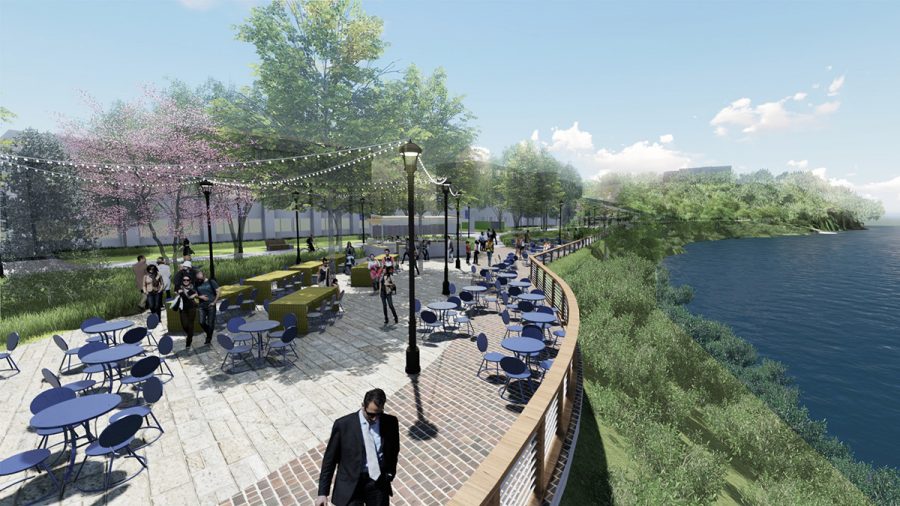Construction will soon begin on the Garfield Avenue project
While crucial repairs are made below, the waterfront location will be enhanced above
More stories from Deanna Kolell
Photo by Submitted
The Garfield Avenue project includes an overlook along the Chippewa River bank, adding more outdoor spaces for people to gather.
Remodeling and repairing Garfield Avenue has been a project in the works since 2008, and at last, the physical renovations will commence this spring.
Mike Rindo, the assistant chancellor for facilities and university relations and the chair of the Garfield Avenue project committee, said the undertaking was part of the 2010/2030 master plan, which serves as a roadmap for campus facility development.
Rindo said the Garfield Avenue project came about after hearing what the future campus infrastructure should look like from numerous constituents.
“People wanted to incorporate the river more meaningfully into campus life,” Rindo said. “What this (project) does is it eliminates the barrier that is currently the city street and creates outdoor spaces where people can gather by the river.”
A number of changes will be made to Garfield Avenue over the next couple of years in order to transform it from a city street to a bicycle and pedestrian thoroughfare. Changes include the reconfiguration of the south end of the footbridge, removing the Putnam parking lot to create an outdoor classroom space, creating an overlook along the Chippewa River and building an amphitheater.
By creating more outdoor gathering spaces, Rindo said the Chippewa River and lower campus will allow people to congregate and experience the beauty of the Chippewa River.
Because Garfield Avenue will be a street solely for pedestrians and bicycles, Rindo said vehicular traffic will only be allowed as far as the Ecumenical Religious Center, except during move-in and move-out of the dormitories. The street will also allow access to emergency and service vehicles.
In addition, slight changes will also be made to the hill, Rindo said. The base of the hill will be smoothed out and the slope reduced. A large U-shaped bend will lead to the pedestrian area below, serving as a deterrent for any cyclists going too fast.
With the extensive improvements, some adjustments must be made during construction and after the project is completed. For example, Rindo said transforming the Putnam parking lot into an outdoor classroom will displace 40 parking spots, which will be accommodated in either Towers or Bollinger lot.
The footbridge will be closed for the summers of 2017 and 2018, but it will be open during the academic year. Rindo said construction could be disruptive because it will take two construction seasons, beginning spring 2017 through fall 2018, with access to the sidewalk in front of Putnam and Katherine Thomas halls being limited.
However, Rindo said news about construction will be relayed in an open and timely manner.
“We’ll be communicating with campus on an ongoing basis to make sure people know when the project will start, how it’s progressing, when there’ll be a lot of deep digging going on,” Rindo said. He added heavy equipment would not disrupt students by running late at night or early in the morning.
Although the surface of Garfield Avenue will be renovated extensively, Rindo said the primary function of the project is to replace the aging and failing utilities below Garfield Avenue, which will comprise about 75 percent of the project’s budget.
Rindo said some of the changes include replacing the sanitary sewers and steam lines to reduce heat loss, which will also work toward creating a more sustainable campus.
The project will also utilize hardscape materials, Rindo said, to allow water to penetrate the ground. By using this material and a biofiltration system, contamination will be reduced by filtering for stormwater runoff.
Rindo said 213 trees will be planted in addition to the 100 trees which are part of the Centennial tree project.
With all the planned changes, the total budget came to $12.4 million as enumerated in the 2013-15 state budget. Rindo said the cost will be split nearly halfway between general purpose revenue bonds — which are supported by tax dollars taken in by the state of Wisconsin — and program revenue supported borrowing, which is student fee-based.
Junior political science student Katy McGarry, who is serving as Student Senate chief of staff and student representative on the Garfield Avenue project committee, said although there will be some inconveniences moving forward, nothing will be too inhibiting, especially considering the end product.
“With these gathering areas, there will be more opportunity for large events to take place outside on our campus which will be beneficial to students,” McGarry said. “I think that it will define the next stage of this campus and really highlight why they call it ‘Wisconsin’s most beautiful campus.’”
Substantial completion of the Garfield Avenue project is projected for October 2018. To learn more about the planned renovations, visit the project’s website.


